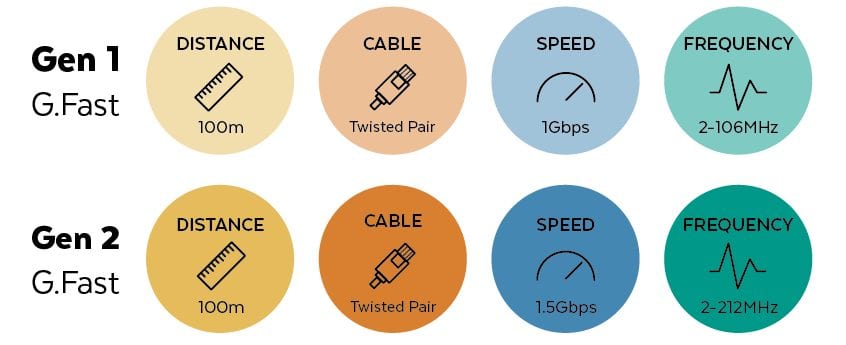Thanks to the ongoing competition between Telcos and Cable Providers, broadband technology—the technology that allows high speed internet services over existing infrastructure—is getting a whole lot better.
The questions these companies have been trying to answer is: how you get faster service to subscribers while still keeping costs down?
The answer is: G.Fast.
G.Fast has been 3-4 years in the making. What’s truly great about this ultra-fast solution is it allows organizations and their installers to reuse existing copper, fiber, and coax, while giving providers the ability to stay competitive by cutting down on overhead and then passing those savings along to customers.
Versa had the opportunity to speak to Mileend Gadkari, VP of Business Development at Sckipio, about the current state of G.Fast and what’s coming down the speedway to customers.
 |
Do things right the first time.
That’s what keeps customers satisfied. That’s the axiom of G.fast. |
Getting to the need | Gen 1 versus Gen 2
The 1st iteration of G.Fast reaches 1 Gbps on Cat3 [existing phone wiring in buildings] at a distance of 100m. Installers are using coax, too, and finding it’s even better.
The good news is, 2nd generation speeds are clocking at 1.5 Gbps and higher over twisted pair. Remarkably, the design team at Sckipio is able to do this because of a simple change of frequency. The first generation chipsets operated at a 2-106MHz frequency; the second generation operates at a frequency range of 2-212Mhz.
This new spectrum allows providers the ability to reach 2-gigs of combined upload and download speed. People can move a lot of data, quickly with that kind of responsiveness. Generation 2 G.Fast is helping us reach our objectives, while helping customers do the same.
 Key Objectives for G.Fast Deployment
Key Objectives for G.Fast Deployment
Recently, Broadband Trends ran a survey among operators that revealed the top reasons providers have for deploying G.Fast. Listed from most unanimous to least here are some of the solutions that G.Fast is solving.
- The push for faster speeds (more than 250 Mbps but less than 1 Gbps)
- Deployment of Advanced Broadband (BB) in multi-dwelling units (MDU) with copper infrastructure
- Deployment where Fiber drops won’t work
- Time to market
- Lower cost than Fiber to the Home (FTTH)
- Enables 1 Gbps speeds
- Deployment of Advanced BB in MDUs with coax infrastructure
- Extend life of existing copper plant
(Source: Broadbandtrends)
Why G.Fast is so popular across the board
Damaged walls in the last mile has been a nightmare for building owners, installers and their customers who simply want to enjoy better Internet speeds and quality signals.
The whole idea behind G.Fast is to prevent installers from having to pull more cables. It prevents hassle.
You can see it deployed in a number of situations.
- Multi-dwelling units
- Single-family units
And, we are now achieving Fiber to the Street at 100-300m. That’s a clear indicator of how this technology continues to improve.
End results are important but developers have taken this a step further. They’re helping installers assess the starting point of an installation better, too.
G.Fast enhances site assessment capabilities
One use case problem that G.Fast solves is HOW an installer can know if existing copper is good enough for a fresh installation.
Sckipio has developed a Digital Processing Unit (DPU), a single-port device that acts like an extender, that simplifies site surveys.
NOTE: those who have pulled-their-hair-out in VDSL wiring experiences should not equate these experiences with what will happen with G.Fast.
Benefits to installers
This is definitely an instance where time-to-market can help installers make more money while saving time. With help from the DPU installers can:
- Survey sites ahead of time.
- Handle installs more quickly.
Data from the DPU alerts the installer to ensure there are no problems.
Do it right the first time. That’s the axiom with G.Fast. That way, there are NO headaches and NO angry customers.
Using this device, installations tend to be done for the whole building the same day.
G.Fast uses existing infrastructure and yet provides better quality outcomes. Speeds of 750 Mbps are not uncommon. Speed tiers jump depending on locations.
Who is rolling out this technology?
G.Fast currently caters to two tiers of customer:
- Telcos – ATT, Century [these are level-1 backbone ISPs]
- Cable companies – Spectrum, Sonic
Make no mistake about it. Competition is tough. Fiber will definitely yield the best results but it’s also very expensive, and many people want alternatives for the last mile with no disruption. They don’t want to deal with holes in their walls, and they want to keep costs down.
Gadkari reports that there are 2 basic problems that hinder broadband upgrades: cost and right of way disputes. This is what is preventing the use of fiber—not only in the US but also Europe.
Current results with G.Fast
Gen 1: A big success. Much has been learned. The Telcos are highly motivated. We’re finding, though, that quarterly earnings are going to the Cable companies.
Gen 2: This version is in final stages of development and is in trial phase and soon to appear. Stay tuned.
Final thoughts
As with media conversion technology, coax is emerging as a viable contender in the reuse of infrastructure and plenty of it remains as a legacy of earlier Internet installations.
The ability to do site surveys also cuts down on hassle later when the potential for infrastructure fails has been eliminated.
As word of mouth continues to percolate due to the stunning results of G.Fast technology, the hope is that right of way disputes will be overridden by plain common sense. At the end of the day, it’s the customers who suffer when red tape slows down advancement.
We trust you enjoyed learning more about the current state of G.Fast.
Our thanks goes to Mileend Gadkari, Vice President of Business Development at Sckipio Technologies, for taking time out of his busy schedule for this discussion.

